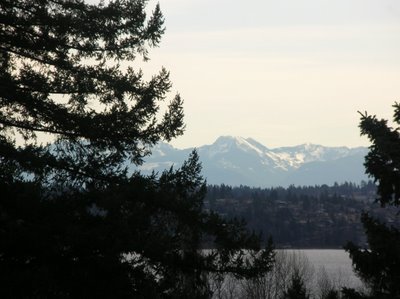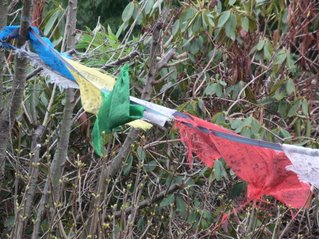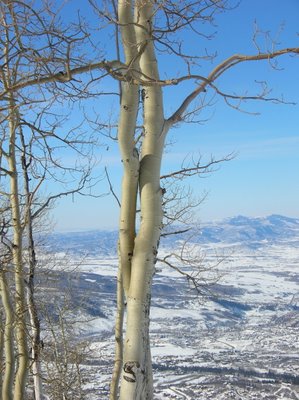 After talking today with a dear friend about his obviously powerful practice of kundalini yoga (a practice that awakens the energy lying like a serpent coiled at the base of spine, which then rises to enable the yogi's individual consciousness to merge with the Divine Consciousness), I remembered that my hero-friend Bill Mitchell practiced and taught a type of kundalini yoga for many years. I have had a sweet strong sense of Bill yesterday and today as a being who has suddenly shifted form, merged with the cosmos, gone super-nova, and become an intense radiance that has lit up the stars in our eyes... and now I recall a lovely comment that Chris wrote at Ashley's when a soul friend of theirs died a month ago at the solstice: "I have had this image with me all day of a star exploding, shedding layers and layers and seeding many new stars all around."
After talking today with a dear friend about his obviously powerful practice of kundalini yoga (a practice that awakens the energy lying like a serpent coiled at the base of spine, which then rises to enable the yogi's individual consciousness to merge with the Divine Consciousness), I remembered that my hero-friend Bill Mitchell practiced and taught a type of kundalini yoga for many years. I have had a sweet strong sense of Bill yesterday and today as a being who has suddenly shifted form, merged with the cosmos, gone super-nova, and become an intense radiance that has lit up the stars in our eyes... and now I recall a lovely comment that Chris wrote at Ashley's when a soul friend of theirs died a month ago at the solstice: "I have had this image with me all day of a star exploding, shedding layers and layers and seeding many new stars all around."So many new stars.
I think that this star-burst/snake-uncoiling energy is an ecstatic one. An energy that takes us far beyond our ordinary sense of who we are, beyond where we think we end and the rest of the universe begins. A power that we experience at numinous times like these, when the veil floats aside for a moment and we are tossed high and low by the great winds of life and death. When we feel pinned through the heart to this present time; and when there's nothing left of us to be pinned, because we've already been dissolved into the fertile emptiness.
An energy to appreciate, and maybe, like my friends, to cultivate.
"Many myths...speak of a snake that glides, sinuous and silent, through the shimmering branches of the body-tree. Universally, the snake symbolizes the primordial creative energy of the cosmos in general and the life force within the body in particular. What we call ecstasy is the dance of the serpent through the tree of our consciousness.
--
"If you think of your body as a house, the serpentine force is the electricity that flows through all the rooms and lights them up. Seen with the inner eye, every living body appears luminous -- it shines, shimmers and scintillates, each cell a little star.
--
"Ecstasy is always a gift of grace. Its comings and goings cannot be controlled...Or, as Rumi puts it, "God's joy moves from unmarked box to unmarked box."
~Jalaja Bonheim, PhD
Unmarked Boxes
Jalal al-din Rumi
translated by Coleman Barks
Don't grieve. Anything you lose comes round
in another form. The child weaned from mother's milk
now drinks wine and honey mixed.
God's joy moves from unmarked box to unmarked box,
from cell to cell. As rainwater, down into flower bed.
As roses, up from ground.
Now it looks like a plate of rice and fish,
now a cliff covered with vines,
now a horse being saddled.
It hides within these,
till one day it cracks them open.
Part of the self leaves the body when we sleep
and changes shape. You might say, "Last night
I was a cypress tree, a small bed of tulips,
a field of grapevines." Then the phantasm goes away.
You're back in the room.
I don't want to make any one fearful.
Hear what's behind what I say.
Tatatumtum tatum tatadum.
There's the light gold of wheat in the sun
and the gold of bread made from that wheat.
I have neither. I'm only talking about them,
as a town in the desert looks up
at stars on a clear night.
Jalal al-din Rumi
translated by Coleman Barks
Don't grieve. Anything you lose comes round
in another form. The child weaned from mother's milk
now drinks wine and honey mixed.
God's joy moves from unmarked box to unmarked box,
from cell to cell. As rainwater, down into flower bed.
As roses, up from ground.
Now it looks like a plate of rice and fish,
now a cliff covered with vines,
now a horse being saddled.
It hides within these,
till one day it cracks them open.
Part of the self leaves the body when we sleep
and changes shape. You might say, "Last night
I was a cypress tree, a small bed of tulips,
a field of grapevines." Then the phantasm goes away.
You're back in the room.
I don't want to make any one fearful.
Hear what's behind what I say.
Tatatumtum tatum tatadum.
There's the light gold of wheat in the sun
and the gold of bread made from that wheat.
I have neither. I'm only talking about them,
as a town in the desert looks up
at stars on a clear night.

















